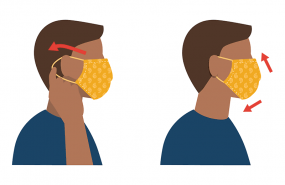Almost a year into the COVID-19 pandemic, mask recommendations are still updating as new data becomes available.
While it's no question that wearing one mask is better than not having any mask at all, some are wondering if a single cloth mask is enough to stop the spread of the virus as more contagious variant strains are discovered.
“So if you have a physical covering with one layer, you put another layer on, it just makes common sense that it likely would be more effective,” Dr. Anthony Fauci said this week on the “Today” show.
But what are the basic do's and don'ts of mask wearing?
Before putting on your mask, wash your hands or use hand sanitizer.
Put the mask over your nose and mouth and secure it under your chin.

As always, make sure you can breathe easily.
Masks should be worn in public settings when you're around people who don’t live in your household, especially when indoors and when it may be difficult for you to stay six feet apart from people who don’t live with you.
Remember that a mask is NOT a substitute for social distancing.
The mask must be worn correctly for maximum protection.
According to the CDC, your mask should have two or more layers of washable, breathable fabric.
CDC data shows that a two-layer cloth masks blocks 50 to 70% of fine droplets and particles in addition to limiting the forward spread of those particles.
The mask should completely cover your nose and mouth and fit snugly against the sides of your face without gaps.
If you have to continually adjust your mask, it doesn’t fit properly, and you might need to find a different mask type or brand.
The CDC does not recommend masks that are made of fabric that makes it hard to breathe, for example, vinyl, or masks that have exhalation valves or vents which allow virus particles to escape. The CDC has not recommended the public use N95 respirators as N95s should be reserved for health care workers.
When it comes to gaiter-style face coverings, the CDC says to wear a gaiter with two layers, or fold it to make two layers. The evaluation of face shields is still ongoing, but effectiveness is unknown at this time, so the CDC does not recommend you use these as a substitute for masks.
As the winter brings cold weather, remember that scarves, ski masks and balaclavas are not substitutes for masks.
Do not touch your mask when you are wearing it. "If you have to often touch/adjust your mask, it doesn’t fit you properly, and you may need to find a different mask or make adjustments," according to the CDC.
Below are examples of how NOT to wear a mask:

When you're taking off your mask, carefully untie the strings behind your head or stretch the ear loops, touching only the earloops or ties.
Be careful not to touch your eyes, nose, and mouth when removing your mask and wash your hands immediately after removing.
Reusable masks should be washed regularly, according to the CDC.
To clean your mask:
- Include your mask with your regular laundry
- Use regular laundry detergent and the warmest appropriate water setting for the cloth used to make the mask
- Use the highest heat setting and leave in the dryer until completely dry
For more information, on how to wash your mask click here.
For more information on face coverings, click here.


